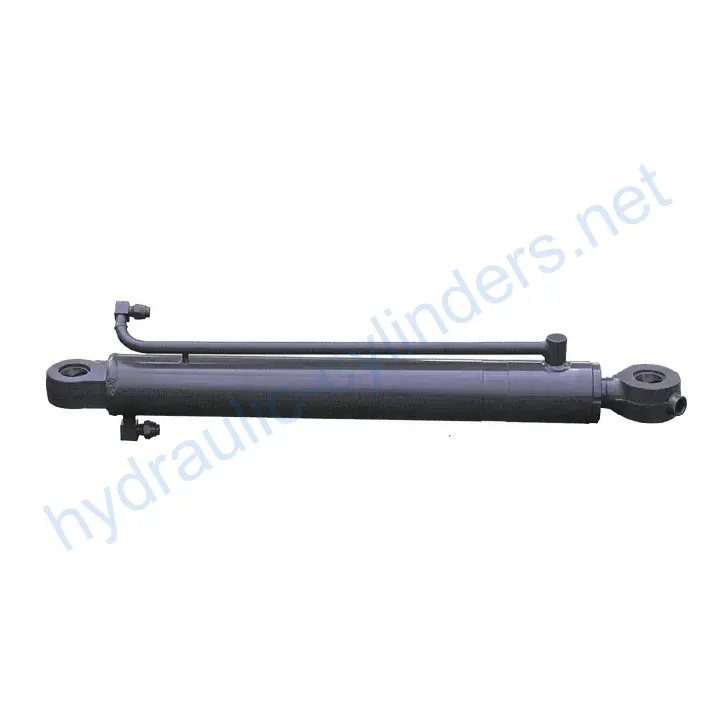Bucket Cylinder For John Deere E300LC
Som en av tillverkarna, leverantörerna och exportörerna av mekaniska produkter erbjuder vi hydraulcylindrar och många andra produkter.
Vänligen kontakta oss för mer information.
E-post:sales@hydraulic-cylinders.net
Tillverkare, leverantör och exportör av hydraulcylindrar.
Bucket Cylinder For John Deere E300LC
Introduction
A bucket cylinder is a specifically designed hydraulic cylinder primarily used to control the movement of a bucket in heavy machinery such as excavators, backhoe loaders, and front-end loaders. Its main function is to enable the bucket to lift, lower, and tilt for ease of material handling tasks. In the hydraulic system, the bucket cylinder achieves precise control of the bucket through changes in hydraulic oil pressure, enabling operators to efficiently handle heavy loads and adapt to complex work environments and job demands.

Features
- High Strength and Durability: Typically made of high-strength steel or aluminum, it can withstand high pressure and heavy loads, adapt to harsh working environments, and is designed with wear resistance and corrosion resistance to extend its service life.
- Efficient Hydraulic Operation: Utilizing hydraulic oil pressure to achieve smooth extension and contraction movements, it can quickly respond to control commands and provide strong pushing and pulling forces, making it suitable for handling heavy loads and complex job tasks.
- Various Types: Single-acting (using hydraulic in one direction only) or double-acting (using hydraulic in both directions) cylinders can be selected according to operational needs. Some models are telescopic, allowing for greater extension without increasing external dimensions, making them suitable for space-limited applications.
- Can be Produced by Us: Our product can perfectly replace these hydraulic cylinders.

Applications
The bucket cylinder is widely used in various industries, including:
- Construction Equipment: In excavators, they are critical for digging, loading, and moving soil or debris. In backhoe loaders, the bucket cylinders contribute to both digging and lifting.
- Agricultural Machinery: Used for front-end loaders, picking up, lifting and transporting soil, hay, and other materials.
- Excavators: The bucket cylinder realizes the digging action by allowing the bucket to penetrate the soil.
- Loaders: In front-end loaders, they assist in lifting and tilting goods effectively.
Design Considerations and Selection Criteria
From design considerations, such as load-bearing capacity, sealing, durability, safety, and maintainability, the bucket cylinder should be selected based on specific operational needs.
- Load-Bearing Capacity: The cylinder should be able to hold the loads it is expected to carry. Considering the work environment, it should meet design standards that ensure it is capable of handling the loads and stresses it will encounter.
- Sealing: The cylinder should have high-quality seals to prevent leakage, which could cause damage to the cylinder and surrounding equipment.
- Durability: The cylinder should be made of high-quality materials that are resistant to wear and corrosion, which can extend its lifespan and reduce maintenance costs.
- Safety: The cylinder should be designed with safety in mind to prevent accidents and minimize risk, such as avoiding sudden movements and ensuring proper mounting.
- Maintainability: The cylinder should be easy to maintain and repair, with parts readily available, and have clear and concise maintenance instructions.

Sealing and Lubrication
The bucket cylinder uses various seals, such as piston seals, rod seals, etc., made of wear-resistant materials such as polyurethane and nitrile rubber, effectively preventing oil leakage. The cylinder body and threaded end surface undergo precision processing to improve wear resistance and durability. The cylinder requires regular lubrication with the appropriate hydraulic oil to ensure smooth operation.
Maintenance and Repair
Regular maintenance and preventive measures can help extend the life of the bucket cylinder, including:
- Regular inspection
- Appropriate lubrication
- Seal replacement and calibration check
It is important to correctly align and install the cylinder, use appropriate installation brackets to secure the cylinder, and follow recommended inspection, repair, and replacement procedures. Replacement parts and rebuilding services are also available to enhance the lifespan of the cylinder.

Safety Considerations and Environmental Factors
When using the bucket cylinder, it is essential to follow safety measures to prevent accidents and damages. Environmental factors such as temperature and humidity should also be taken into account when selecting the appropriate cylinder.
Troubleshooting and Common Issues
Common issues with the bucket cylinder include leakage, seal damage, and slow or uneven movement. Troubleshooting can identify the problem and determine the appropriate solution. Preventive measures can help minimize potential problems, such as regular inspection and maintenance.

About Us
We are a leading manufacturer and wholesale distributor of hydraulic cylinders in the domestic and international markets. We offer a complete range of products and adhere to excellent quality standards. We rely on industrialized production management strategies through our fine manufacturing workshops, which continually improve manufacturing platforms, perfect product quality production lines, and have strong creative capabilities to meet customer needs efficiently, accurately, and with high quality.
We are committed to providing professional, international certified, customized services, and have advanced production equipment and professional after-sales services, among other strengths, to help us stand out in the market.

Author: lyl
Take a Tour of Our VR Factory:
Take a tour of our VR factory with the following
How Does Forklift Hydraulic Cylinder Work?
Hydraulic Cylinder Application:


